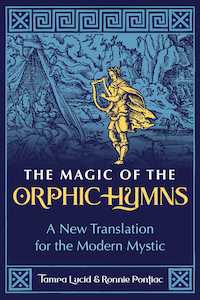
The Magic of the Orphic Hymns: A New Translation for the Modern Mystic, by Tamra Lucid and Ronnie Pontiac
Inner Traditions, 1644117207, 288 pages, August 2023
The mythical musician Orpheus charmed fish, sirens, and weary heroes with his songs while sailing with Jason and the Argonauts in pursuit of the Golden Fleece, but he is best known for his doomed love affair with Eurydice, who died after she was bitten by a snake while fleeing a rapist on their wedding day. Orpheus was so distraught that he descended into the Underworld and convinced Persephone, the Queen of the Dead, to resurrect his wife, on the condition that he not look back while leading her out of Hades.
However, in his eagerness to reunite with her, he couldn’t resist the urge to turn around, and she slipped away from him once again. Upon returning to the surface without his beloved wife, he founded the mystery religion that bears his name and the maenads tore him apart, mirroring the dismemberment of Dionysus by the Titans. A collection of 87 religious poems, known as the Orphic Hymns, were attributed to this cult hero, though the true origin and authorship of them is shrouded in mystery.
In The Magic of the Orphic Hymns: A New Translation for the Modern Mystic, co-authors Tamra Lucid and Ronnie Pontiac revitalize the traditional hymns with fresh new poetic renderings in contemporary English. Like Orpheus, the husband and wife duo are mystical musicians themselves, who founded the experimental rock band Lucid Nation. Both were initiated into the underground music and occult scene of Los Angeles, and Pontiac apprenticed under the metaphysical scholar Manly Palmer Hall. Lucid wrote about their experiences in Making the Ordinary Extraordinary: My Seven Years in Occult Los Angeles with Manly Palmer Hall (2021).
The authors first began working with the hymns in the 1980s, when Pontiac assisted members of Hall’s Philosophical Research Society with a republication of Thomas Taylor’s eighteenth-century translation titled The Mystical Hymns of Orpheus. Pontiac, who was studying ancient Greek in college at the time, was inspired to write his own translation, and Lucid researched the ritual correspondences. Together, they produced the poetic renditions of the traditional hymns contained within this book.
My go-to translation for the past decade has been The Orphic Hymns by Apostolos N. Athanassakis (2013), which is an excellent scholarly resource with extensive footnotes. I was drawn to Lucid and Pontiac’s more flexible poetic interpretations because I’m always looking for beautiful prayers to incorporate into my personal rituals and I thought this book might move me to craft my own hymns as well. However, The Magic of the Orphic Hymns is more than just a divinely inspired poetry collection, and I was impressed by the comprehensive historical background information the authors provide.
In the first half of the book, Lucid and Pontiac explore the origins of Orphism from a well-researched, scholarly perspective, and the influence of Orpheus, “the first rock star,”1 on great minds throughout history. Through their engaging narrative voices, they have a knack for making what might otherwise be dry history entertaining, and this work is peppered with fascinating anecdotes about philosophers and Roman emperors. The far-reaching spiritual influence of Orphism interested me the most, and I was intrigued to learn that the early Christians saw Orpheus’s underworld journey to rescue his beloved wife as mirroring Christ’s harrowing of hell and the liberation of the virtuous souls trapped there.2
Defining the religion of Orphism is tricky, and scholars have debated if it even existed at all.
“Orphic may have been a catch-all phrase in ancient Greece for anything neither Homeric nor Olympian,” writes Lucid and Pontiac. “The phrase could be a generic category for a cluster of related interests, like New Age in our own culture.”3
According to the Neoplatonist philosopher Olympiodorus, Orphics believed that human beings were created when Zeus struck the Titans by lightning after they cannibalized Dionysus. Humanity is therefore like an electrified Frankenstein monster composed of heavenly Dionysian spirit and corrupt Titanic flesh. Through the cycle of reincarnation, the Orphics supposedly taught that humans could purge themselves of their Titanic impurities over the course of multiple lifetimes and liberate their Dionysian divinity.
Followers of the Orphic mysteries led austere lives and restricted their diets by abstaining from meat and beans. However, authors Lucid and Pontiac state that Olympiodorus is the only source for the Titanic origin myth of humanity being Orphic and the Italian scholar Domenico Comparetti concluded that the Orphics believed in reincarnation based on his writings, so this is an educated guess supported by scant evidence. 4
Lucid and Pontiac’s exploration of Orpheus’s wife in a chapter titled, “The Evolution of Eurydice” was especially compelling to me. In the earliest sources, Eurydice is nameless, faceless, and voiceless. She is a shadow projection of Orpheus’s mourning and yearning to possess the woman who was stolen from him by death. She is an ancient victim of the male gaze, doomed to serve as muse for a famous musician while having no true identity of her own.
Her elusive character acquired more substance in retellings. I was fascinated to learn that a name for Eurydice in some early versions of the myth was Agriope, which means “Wild-Eyed.”5 This caught my attention because Agriope is also an epithet for Hekate, the goddess of ghosts and witchcraft, in her capacity as leader of the restless dead. Under the name Agriope, Orpheus’s wife appears to be a hungry ghost sent by the Queen of the Underworld to haunt him.
The authors suggest that Eurydice, whose name means “Wide Justice,”6 sounds more like an epithet for the goddess Persephone in her role as judge of souls than the name of a mortal wife. I’m inclined to agree, because I find the parallels between Persephone and Eurydice to be striking. Eurydice died of a snake bite after a shepherd or satyr attempted to rape her on the day of her wedding to Orpheus, and according to the Orphic Hymn to Persephone, Zeus raped Persephone in the form of a serpent. The fruit of that unspeakable union was Dionysus. Through her untimely death, Eurydice was, in a sense, abducted by Hades, and through Orpheus’s descent into the Underworld, he was reborn as a Dionysian mystic.
Persephone herself is a key figure in the myth for taking pity upon Orpheus and permitting Eurydice’s return to the land of the living, on the condition that he not look back, lest he lose her forever. Yet, despite this warning, he could not resist the urge to do so. In medieval times, Orpheus’s backward glance “was a symbol of human weakness, illustrating the way even the most dedicated among us, the holiest, cannot escape those moments of desire for material pleasures.”7
Carl Jung interpreted Orpheus’s “backward glance” as “a symbol of individuation and the achievement of autonomy.”8 Orpheus was fated to lose the love of his life so he would become the renowned mystic and musician he was destined to be. Sometimes the obligations of a relationship can limit one’s ability to pursue the soul’s true calling, and so Orpheus’s romantic hindrance was removed by the force of death, while simultaneously being used as a guiding light to propel him forward.
This poignant insight resonated deeply with me because I have observed in my own life that love lost or unrequited can be a powerful catalyst for personal growth and transformation. Limerence, or romantic obsession for someone unattainable, can serve a higher purpose when it is sublimated into artistic and spiritual pursuits. When I think back on it, it seems that heartbreak was the catalyst for every major breakthrough and turning point in my life, as if the Universe was redirecting me towards something greater, even though I felt devastated at the time.
The second half of this book contains the “Orphic Charms and the Sacred Songs of Orpheus.” The authors have taken creative liberties with their loose translations of the Orphic Hymns, creating “a poetic work, not a scholarly translation.”9
The charms consist of the cryptic messages that were inscribed on the Orphic golden leaves, which were buried with the deceased as “passwords for the dead, messages to avert forgetfulness.”10 My favorite charm tells the departed initiate what words they must speak to the guardians of the lake of memory in order to drink from it:
“I am a child of earth/and of starry heaven,/but my race is of heaven./This you know./I am parched/and perishing./Give me cold water/from the lake of memory.”11
One of my favorite hymns is addressed to Hermes, who is cleverly described with homophones as the “lover of prophets/and profits”.12 I also adore the hymn to Persephone, in which she is honored as “the star/at the core of the apple.”13 The beautiful aquatic imagery of “The Nereids” reminds me of Hans Christian Andersen’s fairy tale “The Little Mermaid”: “Daughters of Nereus,/you live in the golden castle/at the bottom of the sea./Your steeds are Tritons,/the mermen with wings./You delight in the creatures/of the billowing brine.”14
The Magic of the Orphic Hymns is a poetic odyssey through the history and mystery of Orphism that makes the traditional hymns more accessible to contemporary mystics by rendering them in vivid modern English. Anyone who is curious about the Orphic tradition or interested in revitalizing the hymns in their personal practice will benefit from reading this book. These pages want to be perfumed in incense and awakened with whispered incantations.

Rachel Christina McConnell is a witch, tarot reader, intuitive astrologer, and writing spider. She holds an MFA in Fiction from Columbia University in the City of New York. Her short stories have appeared in Dark Moon Lilith Press and Minerva Rising Press’s The Keeping Room. Links to her publications are available here: https://rachelchristinamcconnell.wordpress.com
